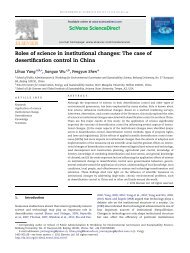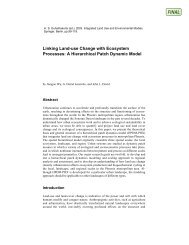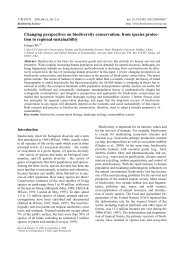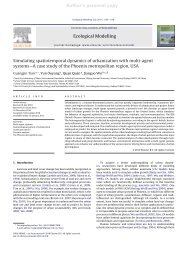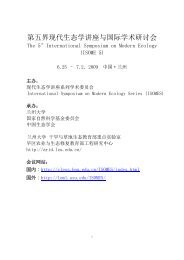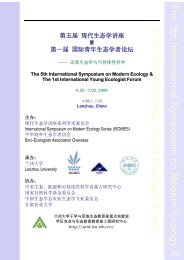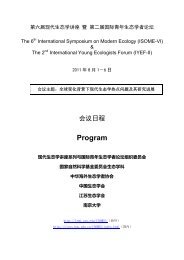Landscape ecology - Arizona State University
Landscape ecology - Arizona State University
Landscape ecology - Arizona State University
You also want an ePaper? Increase the reach of your titles
YUMPU automatically turns print PDFs into web optimized ePapers that Google loves.
Comp. by: THAMIZHVEL V Stage: Galleys Chapter No.: 575 Title Name: ESST<br />
Page Number: 0 Date:7/12/11 Time:00:19:30<br />
4 L<br />
<strong>Landscape</strong><br />
Ecology<br />
255 Evolving Concepts of <strong>Landscape</strong> Ecology<br />
256 The definitions of landscape <strong>ecology</strong> are also diverse,<br />
257 although they are not quite as numerous as those of<br />
258 landscape (Table 1). Images can be powerfully<br />
259 inspiring, and this is especially true to someone who<br />
260 has a special interest in landscape patterns. Partly<br />
261 inspired by the conspicuous spatial patterns revealed<br />
262 in aerial photographs, the German geographer and<br />
263 botanist Carl Troll [19] coined the term “landscape<br />
264 <strong>ecology</strong>” and defined it later as “the study of the main<br />
265 complex causal relationships between the life commu-<br />
266 nities and their environment in a given section of<br />
267 a landscape” [20, 21]. Carl Troll’s training and research<br />
268 in multiple disciplines endowed him with the abilities<br />
269 to synthesize across, and innovate at the interface<br />
270 between, different fields. He was trained as a botanist;<br />
271 did his doctoral dissertation in plant physiology; and<br />
272 then spent decades working on the climatic, geologic,<br />
273 geographical, and ecological aspects of various<br />
274 landscapes in Europe, South America, and Africa. It is<br />
275 not difficult to understand why Troll could simulta-<br />
276 neously appreciate the then-new idea of “ecosystem”<br />
277 put forward by Arthur Tansley [28], as well as the<br />
278 great potential for geospatial analysis presented by<br />
279 aerophotography. As a result of his attempt to<br />
280 integrate the “vertical” ecological approach with the<br />
281 “horizontal” geographical approach, a new field of<br />
282 study was born.<br />
283 In the past several decades, landscape <strong>ecology</strong> has<br />
284 acquired a number of definitions which all are, in some<br />
285 way, related to Carl Troll’s original definition. For<br />
286 example, Zonneveld [22] defined landscape <strong>ecology</strong> as<br />
287 “an aspect of geographical study which considers the<br />
288 landscape as a holistic entity, made up of different<br />
289 elements, all influencing each other.” He advocated<br />
290 that the landscape should be studied as the “total<br />
291 character of a region,” not “in terms of the<br />
292 separate aspects of its component elements” [22, 29].<br />
293 This holistic landscape perspective continues and<br />
294 culminates in the work by Naveh [30], who described<br />
295 landscape <strong>ecology</strong> as the study of “the total spatial<br />
296 and functional entity of natural and cultural living<br />
297 space.”<br />
298 Some key ideas of contemporary landscape <strong>ecology</strong>,<br />
299 such as patch dynamics [31–33] and the patch-corridor-<br />
300 matrix model [11, 12], began to emerge in<br />
North America in the late 1970s, apparently with little<br />
connection to the European root. The early ideas of<br />
landscape <strong>ecology</strong> in North America were inspired by<br />
the theory of island biogeography [34], with an explicit<br />
focus on spatial heterogeneity. The first major communication<br />
between North American and European<br />
landscape ecologists occurred in 1981 when five<br />
American ecologists attended the first International<br />
Congress on <strong>Landscape</strong> Ecology in the Netherlands.<br />
Two years later, 25 ecologists (23 Americans,<br />
1 Canadian, and 1 French) gathered at Allerton<br />
Park, Illinois of USA, to discuss the nature and future<br />
directions of landscape <strong>ecology</strong>. The report of this<br />
historic work, published in the following year [24],<br />
became an important guide to the incipient landscape<br />
ecologists in North America [35].<br />
Why was such discussion necessary after landscape<br />
ecological research had been practiced for more than<br />
40 years in Europe? The answer seems clear from<br />
Forman [36]: “What theory explains the spatial heterogeneity<br />
of energy, nutrients, water, plants, and animals<br />
at the level of a landscape, the setting in which we live?<br />
Alas, none.” To develop such a landscape theory,<br />
broader scales that encompass multiple ecosystems<br />
need to be considered, and horizontal interactions<br />
have to be a focus of study. Thus, Forman and Godron<br />
[11, 12] defined landscape <strong>ecology</strong> as the study of the<br />
structure (spatial relationships among the distinctive<br />
landscape elements), function (flows of energy,<br />
materials, and species among landscape elements),<br />
and dynamics (temporal change in landscape structure<br />
and function) of landscapes. The main theme of<br />
landscape <strong>ecology</strong> in North America, with an unmistakable<br />
focus on spatial heterogeneity, was set in<br />
Risser et al. [24]:<br />
" <strong>Landscape</strong> <strong>ecology</strong> focuses explicitly upon spatial<br />
pattern. Specifically, landscape <strong>ecology</strong> considers the<br />
development and dynamics of spatial heterogeneity,<br />
spatial and temporal interactions and exchanges across<br />
heterogeneous landscapes, influences of spatial heterogeneity<br />
on biotic and abiotic processes, and<br />
management of spatial heterogeneity.<br />
Is landscape <strong>ecology</strong> a subdiscipline of <strong>ecology</strong>?<br />
The term itself apparently suggests that it is. Many<br />
ecologists do consider landscape <strong>ecology</strong> as a branch<br />
of <strong>ecology</strong> (e.g., [6]), and most <strong>ecology</strong> programs of<br />
301<br />
302<br />
303<br />
304<br />
305<br />
306<br />
307<br />
308<br />
309<br />
310<br />
311<br />
312<br />
313<br />
314<br />
315<br />
316<br />
317<br />
318<br />
319<br />
320<br />
321<br />
322<br />
323<br />
324<br />
325<br />
326<br />
327<br />
328<br />
329<br />
330<br />
331<br />
332<br />
333<br />
334<br />
335<br />
336<br />
337<br />
338<br />
339<br />
340<br />
341<br />
342<br />
343<br />
344<br />
345<br />
346




